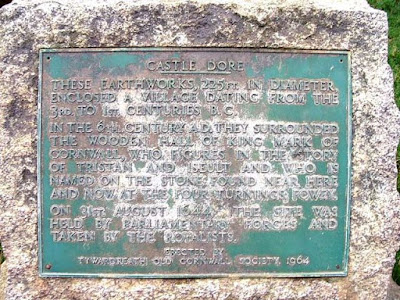As
you may know, I write historical fantasy set a generation after the fall of
King Arthur. In The Du Lac Chronicles, my protagonist, Alden du Lac is the
defeated King of Cerniw and his fort, called Castle Dore, has been razed to the
ground. In The Pitchfork Rebellion, Alden sees first hand what the King of Wessex has done to his beloved fort. I want to have a look at the legend and the archaeological evidence of
Castle Dore today.
Let's
start with the legend.
Castle
Dore was the home of King Mark of Cornwall and was the setting for one of the
most beautifully tragic love story of all times. I am of course talking about Tristan
and Iseult. Move over Romeo and Juliet you have nothing on these guys. If you
want a recap on the legend, then check out the blog post I wrote on Sir Tristan. Now, on to the facts.
Tristan and Iseult as depicted by Herbert Draper (1863–1920)
What
do we know of Castle Dore?
Castle
Dore is situated just outside of Fowey in Cornwall. It is an Iron Age Hill Fort
~ I know I know, not quite the Dark Age fort that we want, but hey, when you
are talking about legends what's 1000 years between friends?!
There
is some speculation that the name Castel Dore comes from the Cornish
"Earth Castle," which has an appealing ring to it, doesn't it?
Excavations
were carried out on the site in 1936 and 1937 by the famed, Dark Age, English
archaeologist and historian Courtenay Arthur Ralegh Radford (1900-1999). He
concluded that the fort was re-occupied in the 5th/6th Century, which would tie
in nicely with the Arthurian legend. Just to note, Radford also excavated sites
at Tintagel and Glastonbury Abbey as well. But later interpretation of the site
suggests that it was an Iron Age fortification, with little of evidence of Dark
Age occupation.
However...The
fort was re-occupied in 1644 by the Earl of Essex and his Parliamentarian Army
during the English Civil War. To cut a long story short, the Royalist
surrounded Dore. Essex managed to escape although there was a great loss of
life. It was a bitter blow to the Roundhead's and ultimately secured the South
West for the king, until the final days of the war.
King Charles I
There
is also evidence of a small village to the eastern gate of the Hillfort and in
my books, Dore does have such a village.
I
wonder why Dore was chosen to be part of the Arthurian story. It is small and
seemingly insignificant and is now being left to crumble away. But whatever the
reason, Dor is associated with the legend and I have to admit, there is
something special about the place.
And if you fancy checking out The Du Lac Chronicles, you can find the link below.





No comments:
Post a Comment
See you on your next coffee break!
Take Care,
Mary Anne xxx